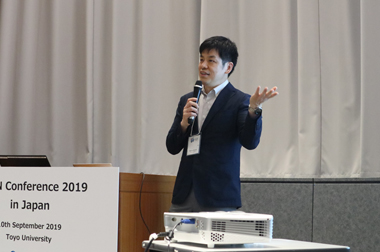過去のカンファレンス
第7回ASQN(Asian Software Quality Network2019)は東京で開催しました!

ASQNカンファレンスが2019年9月10日(火)に東京の東洋大学・白山キャンパスで開催されました。
ASQN とは、ソフトウェア品質が課題となる中、ソフトウェア品質向上の事例や研究などを共有し、グローバルに発信していくことを目的とした、アジアのコミュニティ活動です。活動としては、ソフトウェア品質に関連する研究や経験事例の共有をASQNセッションとして年に1回開催しています。現在、中国、マレーシア、韓国、フィリピン、タイ、シンガポール、ベトナム、インドネシア、日本などアジア各国のソフトウェア関連団体が、参加および参加検討中の状況です。
日本での開催は2015年以来2回目、ソフトウェア品質シンポジウム2019と連続開催されました。参加者は、ASQNメンバーである中国、韓国、マレーシア、タイから多くの方と、一般参加の方も併せて全体で50名を超える方の参加がありました。SQiPの国際活動の一つとして、アジア各国が連携しソフトウェア品質向上に努め、結束を固め、国際競争力を強化するために、アジアにおけるネットワークづくりを構築すべく、ASQNを設立しました。2013年に第1回をクアラルンプール(マレーシア)で、2014年に第2回を上海(中国)で開催し、第3回は東京(日本)で開催しました。今後も毎年、アジア地域で行われるイベントにジョイントするなどし、アジアのネットワークづくりをしています。


1. ASQNカンファレンス概要
今回の発表国は講演順に中国、韓国、マレーシア、日本の4カ国です。中国から1名、韓国から2名、マレーシアから2名、日本からは電気通信大の西先生が講演を行いました。カンファレンススケジュールのように、13時から始まり17時まで発表があり、カンファレンス後には、情報交換や親交を深めるための「ネットワーキング」が東洋大学のカフェテリアで行われました。

【東洋大学・野中先生によるオープニング】
野中先生のオープニングはASQNの目的やこれまでの活動の紹介の後、日本のITトレンドとして「2025年の崖」や、頻発するソフトウェア障害を挙げソフトウェア品質の重要性を述べました。
中国のYang先生の発表は、通訳デバイスを使って中国語で話した内容を英語に翻訳し音声で伝える、”ひとり逐次通訳”という斬新なスタイル。内容は中国のIT産業の現状と課題を挙げました。例えば、上海のソフトウェア産業の市場は2000年からの18年間で118倍にもなり、2018年に中国全体ではソフトウェア会社が37,800社あり、市場規模は6.3 兆元(約96兆円)とのこと。この急激な拡大の中、ソフトウェア開発を担う人材の需要と供給のミスマッチが起き、人材育成が課題なっています。今後のチャレンジとして、CPUなどのハードウェア、OSなどの基本ソフト、さらにその上で稼働するアプリケーションのエコシステムを構築していくことを挙げていました。
韓国のChon氏からは、自動運転支援やドローンに代表されるCyber-Physical-System (CPS)に対するテストメソッドの発表がありました。CPSを対象にしたテストでは、実際のPhysical-Systemを用いてテストを行う際に、実環境の制約が出てきます。その際に、現実の制約に依存せずにソフトウェアをテストする方法をChonさんは開発しました。そのメソッドでは、Diversity (多様性)、Efficiency (効率性)、Safety (安全性)の3つに着目し、実環境を仮想化した環境でのソフトウェアテストを行っています。
韓国のKim氏からもCPSに関係する発表がありました。自身のプロジェクト経験からIndustry 4.0時代におけるソフトウェア品質の考察です。まず、Industry 4.0の説明があり、CPSの自動化レベルの考え方や最適化されたスマートファクトリーの例が共有されました。さらに、ケーススタディーとして自身のプロジェクト経験から、製鉄プロセスの保守支援システムや、大規模建築物のシミュレーションシステムの事例を用いて、安全性、多様性のソフトウェア品質の考察を紹介していました。
マレーシアのAmir(アミール)氏からは、ソフトウェア信頼性に対して、独立検証と妥当性確認(Independent Verification and Validation, IV&V)の取り組みの紹介がありました。彼らはIV&Vハンドブックを作成し、ソフトウェア品質向上に取り組んでいます。そのIV&Vハンドブックではエビデンス(証跡)を重要視し、作業を詳細に定義することによりプロジェクトリスクを低減しています。
マレーシアのHalizawati氏から、ソフトウェア開発プロセスに対するメトリクスを用いた品質向上の取り組みについて発表がありました。一般的にメトリクスといっても、プロダクトメトリクスやプロセスメトリクスなど様々なメトリクスがあり、実際のプロジェクトで使うには取捨選択が必要です。Halizawatiさんの組織では、継続的にメトリクスを使用することによりメトリクス項目を取捨選択し、その結果をProcess Capability Baseline (PCB)として組織で共有するという取り組みをしています。
発表の最後は、日本から西先生(電気通信大学)のAIプロダクト品質保証ガイドラインの紹介です。このガイドラインは、AI プロダクト品質保証コンソーシアム(英⽂名:Consortium of Quality Assurance for Artificial-Intelligence-based products and services, 略称:QA4AI コンソーシアム)で作成され、AIプロダクトの品質保証上の課題とそれらに対する調査と検討がまとめられています。例えば、AIは間違うこともあるので、それをどこまで間違わないようにするのか、または許容するのか、さらに、間違わないようにするための方法は、などを検討しています。対象を具体的な4つの領域、コンテンツ生成システム、スマートスピーカー、産業用プロセス、自動運転に関して現時点の検討結果をまとめています。

【Suwipa Wanasathop, Thailand】
クロージングの中で、今回初参加のタイのSuwipa氏から、カンファレンスの感想と次回のASQNはタイで開催を予定していることの挨拶があり、閉会となりました。

【ASQNメンバーの集合写真】
2. 次回ASQNカンファレンス
次回ASQNカンファレンスの2020年にタイで開催する方向で現在調整中です。
Asian Software Quality Network2019 スケジュール・内容
※ 英語による講演です。同時通訳はありません。
趣旨
 現代社会におけるソフトウェアの重要性に議論の余地はありません。ソフトウェアは、社会基盤として、そして産業基盤として極めて重要であり、多くの製品、システム、プログラムに内在し、その価値を決定しています。現代における多くの工業製品、システムは、ソフトウェアによってその特徴が決定づけられています。
現代社会におけるソフトウェアの重要性に議論の余地はありません。ソフトウェアは、社会基盤として、そして産業基盤として極めて重要であり、多くの製品、システム、プログラムに内在し、その価値を決定しています。現代における多くの工業製品、システムは、ソフトウェアによってその特徴が決定づけられています。
また、ソフトウェアは産業競争力を左右し、国の経済力を左右するといっても過言ではありません。
ソフトウェア産業において、“ボーダーレス”という言葉は、まさに現実のものとなっています。ソフトウェア開発ではオフショア開発が日常的に行われ、世界の複数の国にまたがってプロジェクトを組んで仕事をすることは珍しくありません。
このような中で、ソフトウェア品質向上を実現するために、各国が国際協力に参画することは欠かすことができません。アジアの国際競争力強化のために、連携し、結束を固め、足下を固め、来るべき将来に向けて備えていきたいアジアにおけるネットワークを築き、アジアでのソフトウェア品質向上に努めるため、ANSQを設立します。
目的
- ソフトウェア品質に関する実践的な方法論における知識や経験、そして、ソフトウェアビジネスに適用された組織の成功事例を共有すること
- ソフトウェア品質における優れた成果や能力を発揮しているソフトウェアに関する組織、実務者、研究者のための機会を提供すること
- アジアから発信し、世界にアジアの認知度を高めること
メンバーリスト
- 中国:SSIA(Shanghai Software Industry Association)
- 日本:JUSE SQiP(日科技連SQiP)
- 韓国:K.SEN(Korea Software Engineering Network)
- マレーシア:MSTB(Malaysian Software Testing Board)
- フィリピン:PSIA(Philippine Software Industry Association)
- タイ:SWPT(SoftWare Park Thailand)










